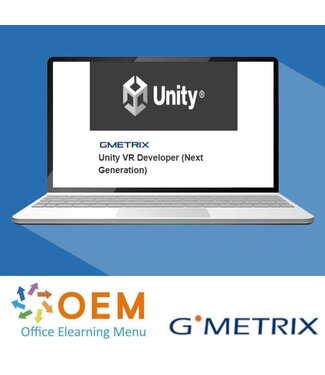Unity VR Developer (Next Generation) oefenexamen
Bereid je met de besten voor op je Unity Certified User: VR Developer (Next Generation) certificeringsexamen. Voel je zelfverzekerd, verbeter je vaardigheden voor het maken van examens en kalmeer je examenvrees met deze oefenexamens. Met een focus op het beoordelen van vaardigheden en een online-gebaseerd formaat zal dit oefenexamen je zeker voorbereiden op je certificering en je een voorsprong geven op de concurrentie in de huidige academische en professionele omgevingen. Deze oefenexamens helpen kandidaten om meer te leren over het ontwerpen, maken en oplossen van problemen met Unity-programma's die VR als medium gebruiken.
Topics:
- 1. Basic Unity Concepts for VR Development
- 1.1. Define essential VR concepts, including but not limited to stereoscopic
vision, how VR differs from other forms of XR, tracking methods, and VR
input methods
- 1.2. Demonstrate how to use Package Manager to manage packages, including
but not limited to the XR Interaction Toolkit
- 1.3. Demonstrate how to import or modify assets, including Prefabs
- 1.4. Given a scenario, identify how to use the Transform component to position,
rotate, and scale an object in the scene
- 1.5. Identify the correct primary interface window to complete a given task while
using the default workspace
- 1.6. Manage components in the Inspector Window
- 2. Building a Scene for VR
- 2.1. Given a scenario, identify common preplanning techniques, including design
documents, flow charts, animatics, character model sheets, prototyping,
greyboxing, storyboarding, concept art, and proportional level scaling
- 2.2. Identify correct methods to implement environment design with 3D objects
using finalized assets
- 2.3. Identify various types of light and when to use Baked vs Realtime lighting
- 3. UX Implementation for VR
- 3.1. Identify the steps to create a basic UI using World Space for a VR scene,
including the use of Canvas, Button, Image, Text, and the Event System
- 3.2. Given a scenario, determine the components needed for a user to physically
manipulate objects, including but not limited to Colliders, the XR Grab
Interactable, and Rigidbodies
- 3.3. Identify types of player locomotion, including degrees of freedom, moving
an avatar, 3-axis motion, 6-axis rotation, and rotating along an axis
- 3.4. Given a scenario, identify optimal VR interactions regarding health and
safety
- 3.5. Differentiate between attributes of audio sources, including but not limited
to 2D and spatial audio
- 4. Scripting with Unity
- 4.1. Given a scenario, select the appropriate basic C# code to achieve a goal
that requires knowledge of properties, variables, methods, basic data types,
or binary operators
- 4.2. Given a scenario, select the appropriate Unity structure to achieve a goal
that requires knowledge of data structures, such as Vector3, GameObject,
Collider, Rigidbody, or AudioSource
- 4.3. Given a scenario, identify how to handle a collision or trigger Enter, Stay, or
Exit event
- 5. Troubleshooting and Playtesting
- 5.1. Given a problem discovered in playtesting, identify areas to troubleshoot,
including Static objects, missing Colliders, missing Rigidbodies, incorrect
settings, Is Trigger, Is Kinematic, or Use Gravity
- 5.2. Identify types of logs in the Console
- 5.3. Identify errors output to the Console and the steps to fix them, including null
references, missing end of line markers, or syntax errors
- 5.4. Identify correct optimization methods when working on a VR scene,
including but not limited to camera occlusion culling, removing unused
objects, or level of detail (LOD)
Includes
Requirements
- The latest version of Chrome, Firefox, Edge, Safari, or Internet Explorer
- High-speed Internet connection
- Prior coursework or experience with Unity is recommended.
Certification
This practice test bundle is preparation for the official Unity Certified User: VR Developer (Next Generation) certification exam.


